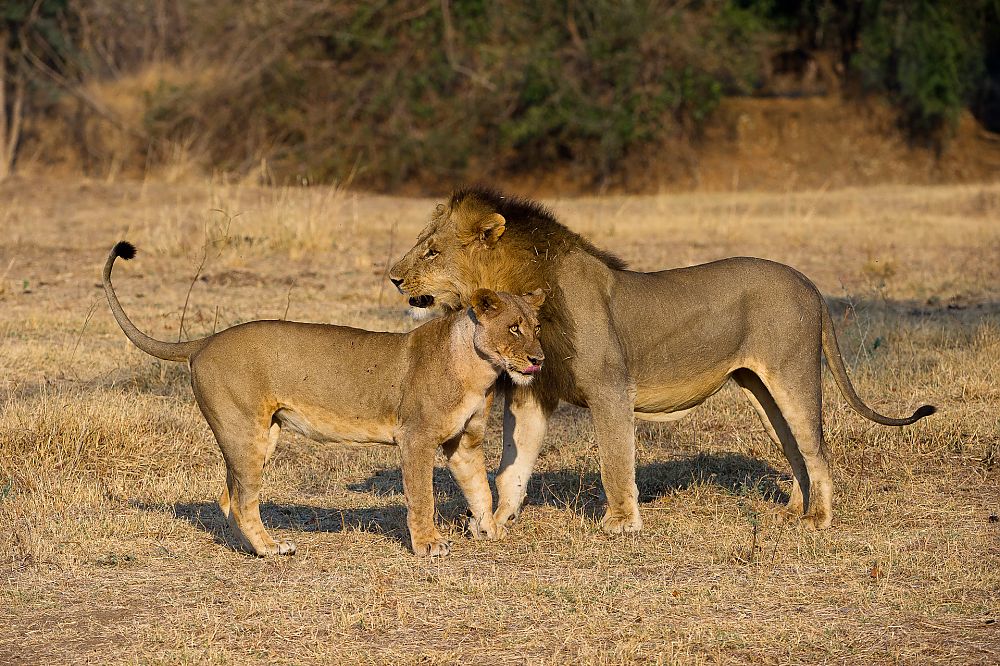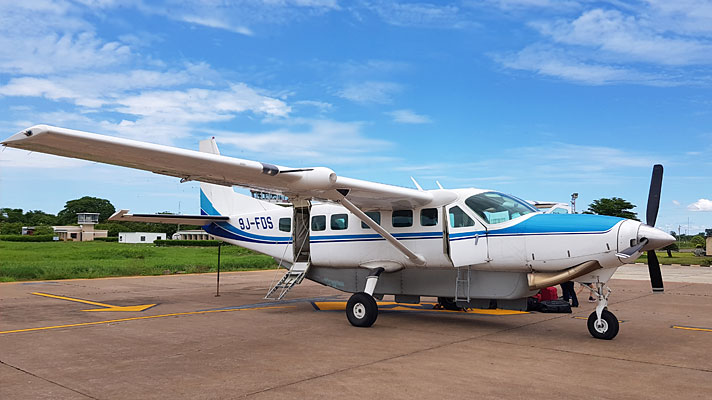THE BIG FIVE
The name “Big Five” originally stemmed from these five animals being the most demanded animals for trophy hunters to find and they were also seen as the top five most dangerous animals in Africa. However, we believe that the only ‘shooting’ that should be done to these animals is through a camera lens; they are definitely an exquisite sight to see! The Big Five can all be found in Zambia, which makes it the perfect place for every safari enthusiast.
1. Leopard
The leopard is one of the most majestic and beautiful animals in the world. They are carnivores with their diet mostly consisting of impalas. Their height is around 50-70 centimetres and their lifespan is approximately 12-17 years. You can find leopards in all of the major national parks in Zambia, however they are usually only active at night time when they’re on the hunt. During the day, you can usually see them lazing around on a tree branch. Leopards can reach a top speed of 58 kilometres per hour and are avid climbers, usually dragging their prey up into trees. You may think that these felines don’t like water, but in fact they are brilliant swimmers!
2. Lion
Lions are mostly recognised by the male’s huge mane. They live in prides that usually consist of 2-3 males and 5-10 females. Once the cubs reach maturity, the older males in the group will kick the younger males out of the pride and they will find another pride. Lions are carnivores and their diet predominantly contains impalas, buffalo, zebra and wildebeest; in one session a lion can eat up to 30 kilograms. The lifespan of a lion is approximately 10-14 years and they average a body length of around 185-210 centimetres. Lions are known for their incredible roaring which usually occurs at night time. You can hear a lion roaring from about 8 kilometres away.
3. Elephant
Elephants are the largest land animals in the world. They can weigh up to 7 tonnes and can reach a height of up to 4 metres. Elephants are herbivores and their diets mostly consists of grass, plants and trees. They can live up to 70 years and their gestation period is 22 months. Elephant calves can stand up just 20 minutes after being born, they can walk after an hour and they can keep up with the heard after just two days. Elephants are very caring and emotional creatures; they always help the injured members of the herd and they are known to mourn the death of a herd member. An elephant’s trunk is extremely heavy – weighing a whopping 180 kilograms and can pick up items as small as a grain of rice.
4. Rhinoceros
Both white rhinos and black rhinos can still be found in Zambia, however both species are endangered and therefore being monitored 24/7 in the national parks. Rhinos can live up to 50 years and are herbivores, with white rhinos being grazers and black rhinos being browsers. These beautiful creatures are known for their horns, which are made up of keratin and similar to human nails and hair. However, the horns are in high demand and poaching has become a major problem in Africa, therefore our rhinos need constant monitoring. When rhinos are happy, they make a “mmwonk” sound with their mouths.
5. Buffalo
Buffalos are a stocky, short-legged species that have horns that are a continuous bone shield and are used for protection against predators, such as lions. They have a lifespan of up to 22 years and they can get up to 170 centimetres in height and up to 340 centimetres in length. Buffalos are herbivores that feed on grasses, sedges and leaves. They can consume 35 litres of water at a time in a matter of minutes.
THE LITTLE FIVE
The Little Five gained their title by having the names of the Big Five in their titles. However, the Little Five are a bit more difficult to spot when on safari compared to the Big Five. These animals are found throughout Zambia and are a must-see for any safari bucket list!
1. Leopard Tortoise
Leopard Tortoises are named after the leopard-like pattern on their shell. The older that Leopard Tortoises get, the smaller their spots become; when they are young they have a dark brown or black pattern which changes with maturity. Like all other tortoises, the Leopard Tortoise is able to use its shell for protection by drawing in their head, tail and legs. These magnificent creatures are found in savanna habitats and are herbivores that feed on grass and succulents.
2. Antlion
The antlion is the smallest member of the Little Five. They are insects that are usually found in dry, arid areas of Africa. Antlions make doodling patterns in the sand and this is the reason that they’re known as doodlebugs in America. They have large jaws which make it easy for them to catch their prey whilst hiding in the sand. They mainly feed on ants, hence their name. The antlion is in the larvae stage of a flying insect called the Antlion Lacewing (pictured below).
3. Elephant Shrew
It is quite obvious where Elephant Shrews get their name – their trunk-like snouts. They use their snouts to sniff out and dig for insects, which make up majority of their diets. Elephant Shrews can grow up to 30 centimetres long and have relatively long legs so that they are able to hop around. They also mark their territory by releasing a scent from a gland underneath their tail. However, Elephant Shrews are fairly shy animals and are not seen often.
4. Rhinoceros Beetle
The Rhino Beetle is named after their exquisite body armour, especially their horn resembling the one of a rhino. They use this horn to fight and protect themselves as well as to dig for food. Their diet consists of rotting wood, bark, sap and vegetable matter. It takes the Rhino Beetle 5 years to mature into an adult, which is relatively long for a beetle species. They can grow up to 2.5 inches long and, relative to their size, are one of the strongest animals in the world.
5. Buffalo Weaver
The Buffalo Weaver is a beautiful bird that can either be the Common Black Buffalo Weaver species or the White-headed Buffalo Weaver species. These birds can get as tall as 9 inches and they feed primarily on small grass seeds, insects and fruits. The Buffalo Weaver species are found in dry areas and have a variety of identifiable calls.
Would you like to have the opportunity to see all of the Big Five and Little Five game? It would be such a special experience to do all in one place: Zambia! If you’d like to enquire about going on a safari in Zambia, please don’t hesitate to reach out to us on DMC@voyagerszambia.com – we’d love to hear from you.






















